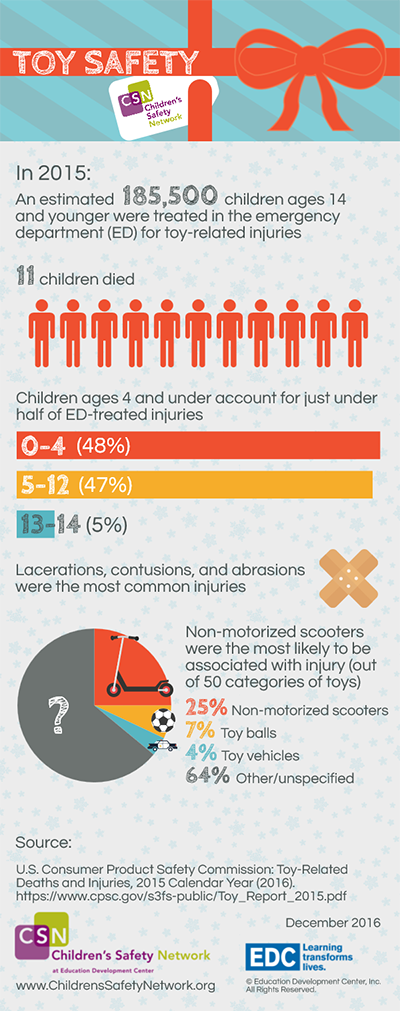
 It’s that time of the year again. With so many new toys on the market, it’s easy for parents to forget toy safety in the rush to finish holiday shopping. The good news is that the U.S. Consumer Product Safety Commission (CPSC) and U.S. Customs and Border Protection (CBP) have already prevented many unsafe toys from hitting the shelves and toy recalls have dramatically declined overall. Unfortunately, many toys can still be dangerous when used improperly or by younger children.
It’s that time of the year again. With so many new toys on the market, it’s easy for parents to forget toy safety in the rush to finish holiday shopping. The good news is that the U.S. Consumer Product Safety Commission (CPSC) and U.S. Customs and Border Protection (CBP) have already prevented many unsafe toys from hitting the shelves and toy recalls have dramatically declined overall. Unfortunately, many toys can still be dangerous when used improperly or by younger children.
A new report by the U.S. Consumer Product Safety Commission (CPSC) found that an estimated 185,500 children under the age of 15 were treated in emergency departments for toy-related injuries in 2015. Children under the age of five accounted for nearly half of these injuries. Cuts, scrapes, and bruises were the most common toy-related injuries, with most injuries affecting the head or face. Out of a total of 50 categories of toys, non-motorized scooters were involved in one out of every four injuries.
There are several things to keep in mind when shopping for toys for children:
Age-appropriateness
Not all “safe” toys are safe for all children—what’s safe for your oldest child may still pose a danger to your youngest. Always follow the age recommendations and read the warnings on toys to check for safety hazards. Teach your older children to keep their toys away from their younger siblings.
Safety Gear
When buying bicycles, skateboards, scooters, skis/snowboards, and similar toys, buy the proper safety gear as well. Make sure helmets are fitted properly. Most helmets should be replaced at least every five to ten years and after an impact.
Button Batteries and Magnets
The small, powerful magnets found in magnetic building sets and desk toys can be lethal when ingested. While some of these products have been recalled, similar items are still on the market.
Button batteries can cause internal chemical burns in less than two hours when ingested. These batteries can be found in some games, toys, musical cards, watches, and flashing shoes. Make sure to keep these away from young children.
Recalls
You can also subscribe to the CPSC Product Recall list to keep track of toys that have been pulled from the market because of safety issues.
CSN has compiled a list of CPSC resources to guide you through safe gift buying:
- Toy Safety Guides
- For Kids’ Sake, Think Toy Safety
- Buying Toys for Children Ages 0–5
- Buying Toys for Children Ages 6–12
- Toy-Related Deaths and Injuries 2015
- Safer Together: CPSC and CBP Collaborate to Keep Unsafe Toys Off Store Shelves
Text from Toy Safety Mini-Infographic:
In 2015:
An estimated 185,500 children ages 14 and younger were treated in the emergency department (ED) for toy-related injuries
11 children died
Children ages 4 and under account for just under half of ED-treated injuries
|
Age |
Number of Injuries |
|
0-4 |
88,700 |
|
5-12 |
87,100 |
|
13-14 |
9,700 |
Lacerations, contusions, and abrasions were the most common injuries
Non-motorized scooters were the most likely to be associated with injury (out of 50 categories of toys)
|
Type of Toy |
Percentage |
|
Non-motorized scooter |
25% |
|
Toy balls |
7% |
|
Toy vehicles |
4% |
|
Other/unspecified |
64% |
Source:
U.S. Consumer Product Safety Commission: Toy-Related Deaths and Injuries, 2015 Calendar Year (2016).